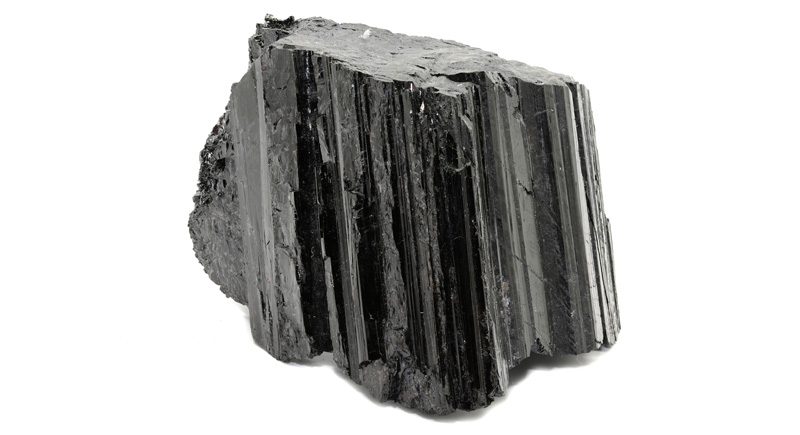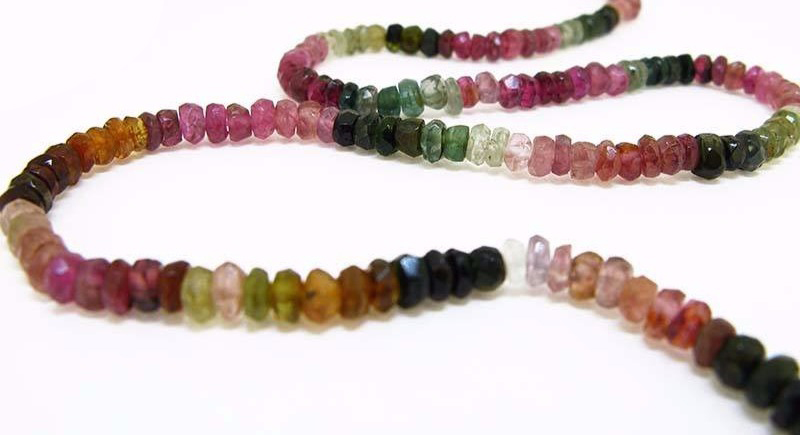

PHYSICAL PROPERTIES
- GROUP Silicates - cyclosilicates
- COMPOSITION Na(Mg,Fe,Li,Mn,Al)3Al6(BO3 )3If6 · 018(OH,F)4
- COLOR Black, green, brown, red, blue, yellow or pink
- CRYSTALLINE SYSTEM Hexagonal / trigonal
- CRYSTALLINE HABIT Prismatic, acicular
- HARDNESS 7 - 7.5
- FRACTURE Unequal to conchoidal
- EXFOLIATION Null
- GLOSS Vitreous
- STRIP Colorless
- TRANSPARENCY From transparent to translucent
- SPECIFIC GRAVITY 3.0 - 3.2
- REFRACTIVE INDEX 1.61 - 1.64
MINERALOGICAL CHARACTERISTICS
The tourmalines are a group of mixed crystals within the family of borosilicates, made up of eleven species, including the schorl (black ), elbaite (pink, red, green, blue) and dravite (brown). The elbaite is the most valued species for its chromatic varieties, among the best known are indigolite (blue), rubellite (pink or red ), watermelon tourmaline (pink interior and green surface), verdelite (green).
The tourmalines are characterized by having a variable composition among them although they have the same crystalline structure. The most abundant is black tourmaline and opaque, called schorl and cathedral. Its crystals are usually prismatic and are usually found in pegmatites, in granites, in hydrothermal veins and in pneumatolithic veins. Tourmaline is a mineral used in industry for its piezoelectric properties.
Deposits: Brazil, India, Afghanistan, United States, Canada, Mexico, Namibia, Russia, Africa and Madagascar.
THERAPEUTIC PROPERTIES
The tourmaline is considered a stone of cleaning, protection and transformation. Whatever the ailment of the physical body, tourmaline helps to regenerate and balance it on an energetic level. It is said that the strength of tourmaline is due to the shape of its parallel grooves, which transform dense energies and increase vibration. There are tourmalines of different colors and each one has its own characteristics.
The tourmaline blue or indigolite is preferably used in the chakras of the throat and third eye, stimulating or balancing communication. It is usually used to heal eye conditions, to reduce inflammation and for headaches, toothaches and earaches.
The tourmaline black is considered the protection stone par excellence. It absorbs dense energies and directs them towards the earth to be transmuted. It is recommended to use it in its natural form of crystallization. The characteristics of black tourmaline make it a widely used mineral in spaces where therapies, cures and healings are carried out. Also in places where you want to keep the environment energetically clean or neutralize electromagnetic waves.
The tourmaline red or rubellite is associated with the 4th and 1st chakras. It is a stone of healing and revitalization of the heart. Treats the reproductive system, strengthens the ability to understand love and enhances sexual activity.
The tourmaline pink is associated with the heart chakra. Activate self love and confidence. It is said to be like a balm for the heart both physically and spiritually.
The tourmaline watermelon is the ideal crystal for the heart chakra because in a single crystal it combines the energy and strength of two (green and pink). Harmonizes, softens and activates the 4th chakra. At a healing level, it is said that it enhances nerve regeneration.
The tourmaline green is considered a stone of healing and transformation. It is said to be a great activator, promoting openness of the heart and prosperity. It is used to relax, to calm the mind, to promote sleep and to strengthen the immune system. It is also often used to improve plant health and growth.


